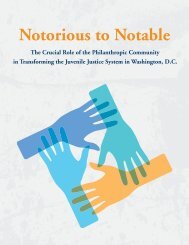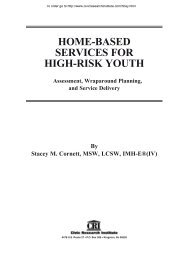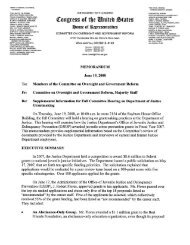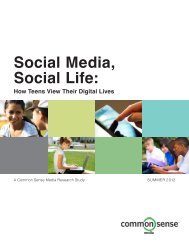- Page 1: Higher Education: Gaps in Access an
- Page 4 and 5: U.S. Department of Education Arne D
- Page 6 and 7: iv Higher Education: Gaps in Access
- Page 8 and 9: and bachelor’s or higher degree c
- Page 10 and 11: Figure 3. (Figure 11-1) Percentage
- Page 12 and 13: Figure 4. (Figure 25-1) Averaged fr
- Page 14 and 15: of females (83 percent) than males
- Page 16 and 17: Among males, Asian/Pacific Islander
- Page 18 and 19: who had not attained a degree had a
- Page 20 and 21: 22. Mathematics and Science Courset
- Page 22 and 23: List of Figures Figure Executive Su
- Page 24 and 25: Figure Page 15-1. Percentage of emp
- Page 26 and 27: Figure Page 36-2. Percentage of und
- Page 28 and 29: Table 13-1. Percentage of students
- Page 30 and 31: Table Page 39-2. Percentage of 2003
- Page 32 and 33: xxx Higher Education: Gaps in Acces
- Page 34 and 35: Within this report, some of the cat
- Page 36 and 37: size of the subgroup for which the
- Page 38 and 39: Chapter 1 Demographic Context 1. Ch
- Page 40 and 41: Indicator 1 Children Living in Pove
- Page 42 and 43: Table 1-1. Percentage of children u
- Page 44 and 45: Indicator 2 Parents’ Educational
- Page 46 and 47: Table 2-1. Sex and race/ethnicity S
- Page 50 and 51: Table 3-1. Sex and race/ethnicity S
- Page 52 and 53: Indicator 4 Language Minority Schoo
- Page 54 and 55: 22 Higher Education: Gaps in Access
- Page 56 and 57: Indicator 5 Special Needs Among 9th
- Page 58 and 59: Table 5-1. Percentage of students r
- Page 60 and 61: Chapter 2 Characteristics of School
- Page 62 and 63: Indicator 6 Segregation and Poverty
- Page 64 and 65: Table 6-1. Sex and race/ethnicity S
- Page 66 and 67: Table 6-2. Number and percentage of
- Page 68 and 69: Indicator 7 Adequate Yearly Progres
- Page 70 and 71: Indicator 8 Types of Public Schools
- Page 72 and 73: Table 8-1. Number and percentage di
- Page 74 and 75: Table 8-2. Number and percentage di
- Page 76 and 77: Indicator 9 Advanced Coursework Off
- Page 78 and 79: Figure 9-2. Percentage of high scho
- Page 80 and 81: 48 Higher Education: Gaps in Access
- Page 82 and 83: Indicator 10 High School Guidance C
- Page 84 and 85: Table 10-1. Sex and race/ethnicity
- Page 86 and 87: Chapter 3 Student Behaviors and Aft
- Page 88 and 89: Indicator 11 Retention, Suspension,
- Page 90 and 91: Table 11-1. Percentage of 9th-grade
- Page 92 and 93: 60 Higher Education: Gaps in Access
- Page 94 and 95: Indicator 12 Safety at School In 20
- Page 96 and 97: Table 12-1. Percentage of students
- Page 98 and 99:
Indicator 13 Alcohol and Other Drug
- Page 100 and 101:
Table 13-1. Sex and race/ethnicity
- Page 102 and 103:
Indicator 14 Homework Most high sch
- Page 104 and 105:
72 Higher Education: Gaps in Access
- Page 106 and 107:
Indicator 15 Part-Time Work The per
- Page 108 and 109:
Table 15-1. Sex and race/ethnicity
- Page 110 and 111:
Indicator 16 School-Sponsored and N
- Page 112 and 113:
Table 16-1. Percentage of 9th-grade
- Page 114 and 115:
Chapter 4 Academic Preparation and
- Page 116 and 117:
Indicator 17 Reading Achievement Am
- Page 118 and 119:
86 Higher Education: Gaps in Access
- Page 120 and 121:
88 Higher Education: Gaps in Access
- Page 122 and 123:
Indicator 18 Mathematics Achievemen
- Page 124 and 125:
92 Higher Education: Gaps in Access
- Page 126 and 127:
94 Higher Education: Gaps in Access
- Page 128 and 129:
Indicator 19 Science Achievement In
- Page 130 and 131:
98 Higher Education: Gaps in Access
- Page 132 and 133:
Indicator 20 Eighth-Grade Algebra O
- Page 134 and 135:
Table 20-1. Percentage of spring 20
- Page 136 and 137:
Indicator 21 Ninth-Grade Mathematic
- Page 138 and 139:
Table 21-1. Sex and race/ethnicity
- Page 140 and 141:
Indicator 22 Mathematics and Scienc
- Page 142 and 143:
Technical Notes This indicator repo
- Page 144 and 145:
112 Higher Education: Gaps in Acces
- Page 146 and 147:
Indicator 23 Advanced Placement Exa
- Page 148 and 149:
Table 23-1. Percentage of test-taki
- Page 150 and 151:
Indicator 24 College Entrance Exams
- Page 152 and 153:
the reading benchmark. Similar raci
- Page 154 and 155:
Table 24-2. Average SAT scores for
- Page 156 and 157:
Indicator 25 Graduation Rates For t
- Page 158 and 159:
126 Higher Education: Gaps in Acces
- Page 160 and 161:
Indicator 26 Status Dropout Rates I
- Page 162 and 163:
Table 26-1. Status dropout rates of
- Page 164 and 165:
Chapter 5 College Knowledge 27. Pos
- Page 166 and 167:
Indicator 27 Postsecondary Plans Am
- Page 168 and 169:
Table 27-1. Sex and race/ethnicity
- Page 170 and 171:
Table 27-2. Sex and race/ethnicity
- Page 172 and 173:
Indicator 28 Steps Toward Postsecon
- Page 174 and 175:
Technical Notes In this indicator,
- Page 176 and 177:
144 Higher Education: Gaps in Acces
- Page 178 and 179:
Indicator 29 Informational Resource
- Page 180 and 181:
148 Higher Education: Gaps in Acces
- Page 182 and 183:
Indicator 30 Postsecondary School C
- Page 184 and 185:
For example, a lower percentage of
- Page 186 and 187:
Indicator 31 Financial Aid Consider
- Page 188 and 189:
Table 31-1. Among 2004 high school
- Page 190 and 191:
Indicator 32 Participation in Colle
- Page 192 and 193:
Chapter 6 Postsecondary Education 3
- Page 194 and 195:
Indicator 33 Enrollment Rates for 1
- Page 196 and 197:
Technical Notes Born within the Uni
- Page 198 and 199:
166 Higher Education: Gaps in Acces
- Page 200 and 201:
168 Higher Education: Gaps in Acces
- Page 202 and 203:
Indicator 34 Entry Into Postseconda
- Page 204 and 205:
Indians/Alaska Natives (35 percent)
- Page 206 and 207:
Table 34-2. Percentage of academic
- Page 208 and 209:
Indicator 35 Price of Attendance an
- Page 210 and 211:
Technical Notes Financial aid amoun
- Page 212 and 213:
Indicator 36 Enrollment Intensity I
- Page 214 and 215:
Table 36-1. Sex and race/ethnicity
- Page 216 and 217:
Indicator 37 Persistence and Attain
- Page 218 and 219:
Table 37-1. Sex and race/ethnicity
- Page 220 and 221:
Indicator 38 Reasons for Leaving A
- Page 222 and 223:
190 Higher Education: Gaps in Acces
- Page 224 and 225:
Indicator 39 Remedial Coursework an
- Page 226 and 227:
Table 39-1. Sex and race/ethnicity
- Page 228 and 229:
Indicator 40 Academic and Social In
- Page 230 and 231:
students (34 percent) participated
- Page 232 and 233:
Table 40-2. Percentage of recent hi
- Page 234 and 235:
Indicator 41 College Student Employ
- Page 236 and 237:
Table 41-1. Sex and race/ethnicity
- Page 238 and 239:
Indicator 42 Graduation Rates and D
- Page 240 and 241:
Technical Notes The overall graduat
- Page 242 and 243:
210 Higher Education: Gaps in Acces
- Page 244 and 245:
Chapter 7 Postsecondary Outcomes an
- Page 246 and 247:
Indicator 43 Educational Attainment
- Page 248 and 249:
216 Higher Education: Gaps in Acces
- Page 250 and 251:
Indicator 44 Labor Force Participat
- Page 252 and 253:
Five percent of young adults who ha
- Page 254 and 255:
Table 44-1. Labor force status of y
- Page 256 and 257:
Table 44-1. Labor force status of y
- Page 258 and 259:
Indicator 45 Median Annual Earnings
- Page 260 and 261:
228 Higher Education: Gaps in Acces
- Page 262 and 263:
230 Higher Education: Gaps in Acces
- Page 264 and 265:
Indicator 46 Employment of Young Ad
- Page 266 and 267:
Figure 46-1. Percentage of young ad
- Page 268 and 269:
236 Higher Education: Gaps in Acces
- Page 270 and 271:
238 Higher Education: Gaps in Acces
- Page 272 and 273:
240 Higher Education: Gaps in Acces
- Page 274 and 275:
242 Higher Education: Gaps in Acces
- Page 276 and 277:
244 Higher Education: Gaps in Acces
- Page 278 and 279:
246 Higher Education: Gaps in Acces
- Page 280 and 281:
Chapter 8 Multivariate Analyses of
- Page 282 and 283:
follow-up round in 2009. Independen
- Page 284 and 285:
Whites: Examining these variables s
- Page 286 and 287:
Table ELS-1a. Percentage distributi
- Page 288 and 289:
256 Higher Education: Gaps in Acces
- Page 290 and 291:
258 Higher Education: Gaps in Acces
- Page 292 and 293:
Degree Attainment Table BPS-1 compa
- Page 294 and 295:
• Full-time enrollment: The odds
- Page 296 and 297:
• School clubs: Black females par
- Page 298 and 299:
Table BPS-1. Percentage distributio
- Page 300 and 301:
268 Higher Education: Gaps in Acces
- Page 302 and 303:
270 Higher Education: Gaps in Acces
- Page 304 and 305:
272 Higher Education: Gaps in Acces
- Page 306 and 307:
Campbell, F.A., Pungello, E.P., Mil
- Page 308 and 309:
MacMillan, R., and Hagan, J. (2004)
- Page 310 and 311:
Appendix A Technical Appendix—Log
- Page 312 and 313:
earned in high school, SAT/ACT test
- Page 314 and 315:
Exhibit A. ELS:2002 variables requi
- Page 316 and 317:
SRMI was conducted independently fo
- Page 318 and 319:
Number of close friends who dropped
- Page 320 and 321:
Appendix B Guide to Sources 288 Hig
- Page 322 and 323:
From kindergarten to 5th grade, the
- Page 324 and 325:
Integrated Postsecondary Education
- Page 326 and 327:
Further information on NPSAS may be
- Page 328 and 329:
Further information on the NHIS may












